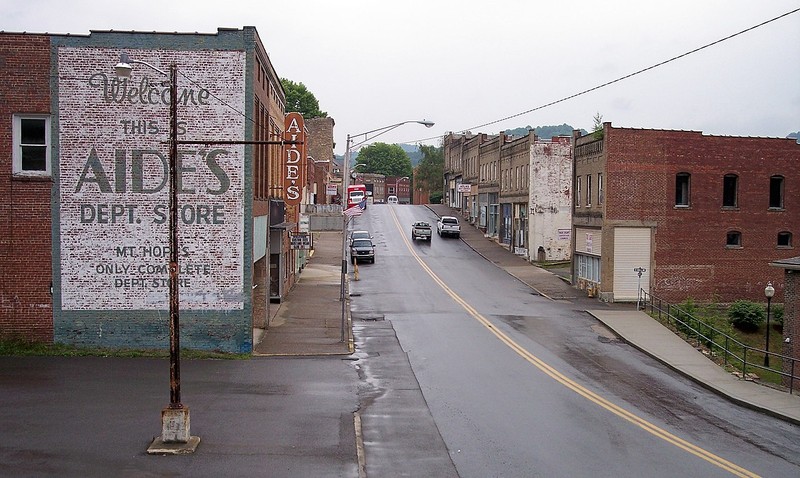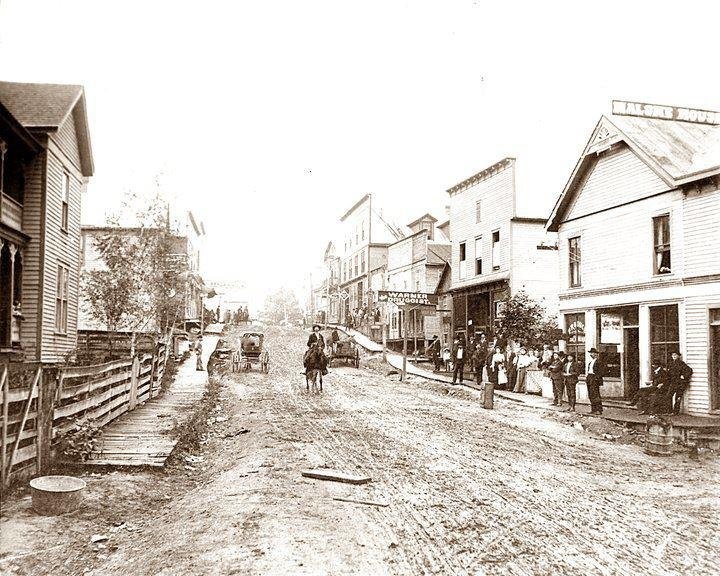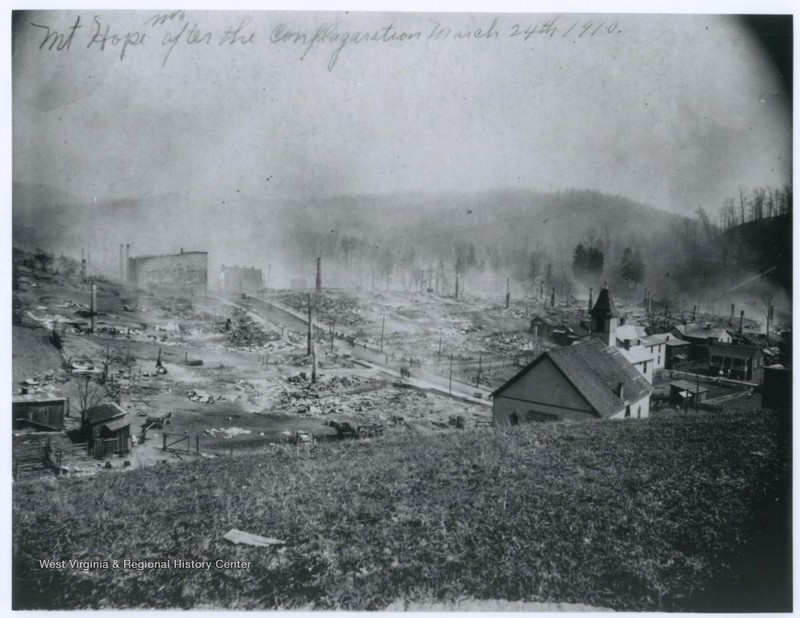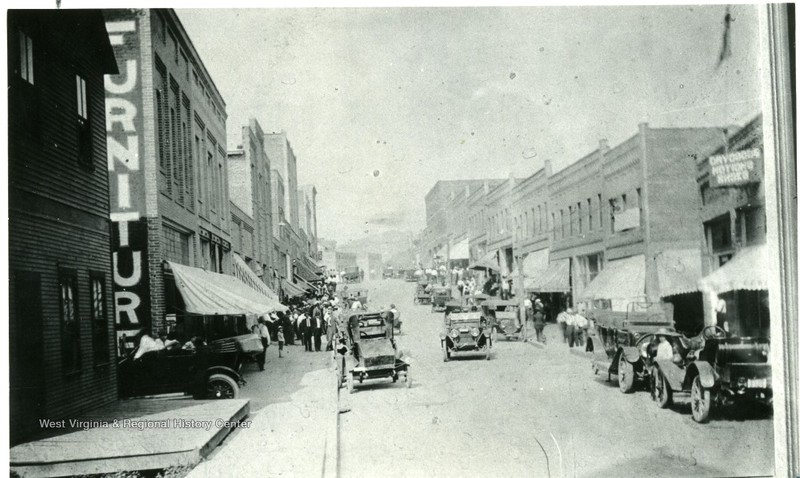This entry includes a walking tour! Take the tour.
Introduction
Text-to-speech Audio
Images
Mount Hope’s Main Street today. Many historic buildings still stand on this stretch, though most are unused.

Main street before the 1910 fire.

Aftermath of the devastating fire. Almost the entirety of downtown Mount Hope was leveled.

Main street shortly after the fire once rebuilding had begun.

Just four years after the fire, Mount Hope had already recovered and was better than before.

Backstory and Context
Text-to-speech Audio
Before European settlers arrived, the area around Mount Hope was utilized by Cherokee Native Americans. The Cherokees sold their rights to all land south of the Kanawha River to the Virginia Colony in 1770, though altercations between European settlers and Native Americans continued until 1794. Following a battle in Ohio between Native Americans and men under the command of General Anthony Waynes, conflict waned near Mount Hope. William Blake Sr. capitalized on this newfound peace by purchasing 3,062 acres in what is now Fayette County. Blake paid about two and a half dollars per acre, or about fifty dollars adjusted for inflation. In 1805, Blake and his family became the first permanent white settlers in the area. The Blakes repurposed a Native American stone fort and also built a log cabin, though it was later destroyed by Union forces during the Civil War.
Despite the rugged terrain of Mount Hope, many travelers passed through the area on their way north or east. Blake offered his cabin as an early inn due to its location near the rudimentary path. When an official state road was to be built through Blake’s land in 1812, he was happy to complete his portion, and ensure that it ran immediately past his inn. Upon Fayette County’s official establishment in 1831, Blake was appointed Justice of the Peace. In 1843, the Kanawha Turnpike was built to link Charleston with the East Coast. This brought an even larger stream of travelers through the Mount Hope area, though only three families lived there permanently. These settlers made their subsistence living through agriculture and husbandry. Their relatively difficult pioneer lives were made easier by the presence of coal outcroppings in the area, which could be easily mined by hand.
The presence of coal in Mount Hope’s area eventually catalyzed the city’s growth. The Chesapeake and Ohio Railroad (C&O) was constructed between 1870 and 1873. It linked the New River Gorge to the rest of the eastern US, opening ample opportunities for business ventures surrounding the coal industry. Fayette County’s population exploded and it became the first county in West Virginia to produce over one million tons of coal in a single year — this record was set in 1888. In 1894, the Loup Creek branch of the C&O was constructed to connect the main C&O line with MacDonald, a town very close to Mount Hope. Mount Hope immediately boomed and within just a few years, four mining operations employing a total of four hundred miners were set up within walking distance of town. The miners were primarily immigrants recruited from eastern and southern Europe and recently emancipated African Americans from the southern US. Evidence suggests that many of the basic infrastructural components of Mount Hope were designed and erected by European stonemasons.
Samuel Dixon’s 1893 arrival in Mount Hope heralded a period of great prosperity for the town. Dixon was superintendent and manager of a number of coal companies. These companies shifted, consolidated, and split, until the New River Company was established in 1906. Many residents in Mount Hope were affiliated with the New River Company in some way. Mount Hope’s prosperity was briefly interrupted by a catastrophic fire in 1910. The largest fire the state had seen up to that point, forty businesses and one hundred fifty homes were destroyed with over one thousand residents left homeless. With over $500,000 in damages, insurance only covered thirty percent of this. However, with the aid of the New River Company, Mount Hope immediately set to rebuilding. Paved streets, sewer systems, electrical access, and new stone buildings, rather than wood, were installed throughout town. Mount Hope became known as “Fayette’s Phoenix City” for its renaissance following the fire. Several of the town’s most significant buildings were erected between 1910 and 1920, including a YMCA, Masonic lodge, coal company offices, several churches, and a new affluent residential neighborhood. Mount Hope was chartered as a city in 1921.
As the twentieth century continued, Mount Hope waxed on waned based on the whims of the coal market. The town was the site of several federal assistance projects such as the 1939 Eleanor Roosevelt backed Stadium Terrace housing project and the 1940 Works Progress Administration constructed post office. World War II helped spur Mount Hope’s economy, as there was renewed demand for coal to fuel war efforts. However, the 1950s marked the decline of coal as a resource. The New River Company slowed production and gradually closed mines in the area. By 1980, the company had vanished from Mount Hope. With the departure of Mount Hope’s coal industry, many businesses left town and the construction of a new bypass route relegated Mount Hope to a shadow of its former glory. Though the town’s population has fallen by almost a third, various preservation and cultural initiatives are striving to keep “Fayette County’s Phoenix City” alive.
Sources
History of Mount Hope, City of Mount Hope. Accessed May 25th 2021. https://mthopewv.org/history/#:~:text=History%20of%20Mount%20Hope,to%20the%20Governor%20of%20Virginia..
Mount Hope, Coal Camp USA. Accessed May 25th 2021. http://www.coalcampusa.com/sowv/river/mthope/mthope.htm.
"Mount Hope Disastrous Fire." Raleigh Herald (Beckley) March 31st 1910.
Mount Hope Historic District, City of Mount Hope. Accessed May 25th 2021. https://mthopewv.org/history/historic-district/.
Mount Hope city, West Virginia, United States Census Bureau. Accessed May 25th 2021. https://data.census.gov/cedsci/profile?g=1600000US5456404.
"Mt. Hope Destroyed by Fire." Raleigh Register (Beckley) March 31st 1910.
"Mt. Hope Swept by Flames." The Fayette Journal (Fayetteville) March 24th 1910. Special ed.
"Mt. Hope in Ruins." The Messenger (Beckley) March 25th 1910.
Taylor, David L. Mount Hope Historic District, National Register of Historic Places. January 1st 2007. Accessed May 25th 2021. http://www.wvculture.org/shpo/nr/pdf/fayette/07000785.pdf.
Wintermantel, Mike. Mount Hope Early Town History, The Historical Marker Database. December 1st 2020. Accessed May 25th 2021. https://www.hmdb.org/m.asp?m=161340.
Kiser, Tim. “Mount Hope West Virginia.” 2007. West Virginia & Regional History Center. Accessed May 25th 2021. https://commons.wikimedia.org/wiki/File:Mount_Hope_West_Virginia.jpg.
“Aftermath of Fire, Mount Hope, W. Va.” 1910. West Virginia & Regional History Center. Accessed May 25th 2021. https://wvhistoryonview.org/catalog/052167.
“Main Street; Mount Hope, W. Va.” West Virginia & Regional History Center. Accessed May 25th 2021. https://wvhistoryonview.org/catalog/042025.
“Main Street, Mount Hope, W. Va.” 1914. West Virginia & Regional History Center. Accessed May 25th 2021. https://wvhistoryonview.org/catalog/002910.
